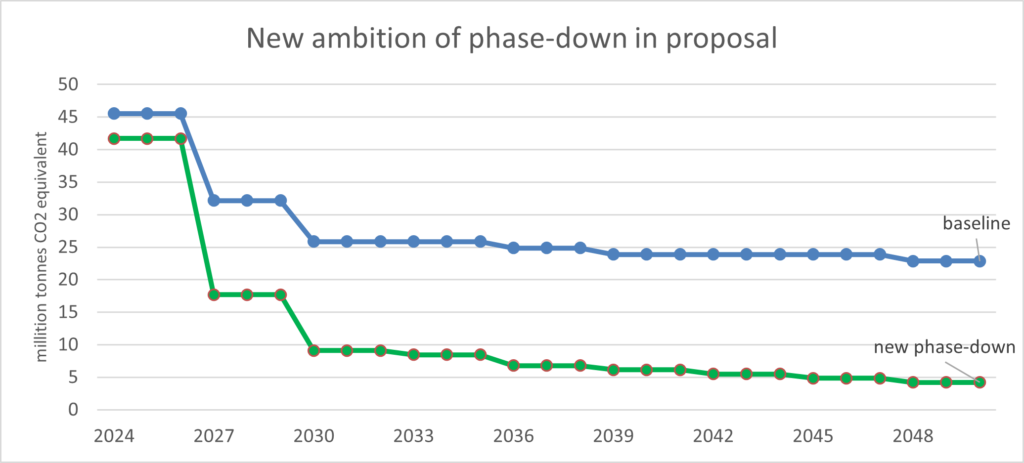Why upgrading the F-gas Regulation is a must
To help meet its declared climate targets, the EU is upgrading its rules on fluorinated greenhouse gases (F-gases) as part of a comprehensive review of all climate relevant legislation. These changes are needed because the EU has stepped up its level of ambition, committing to reduce net greenhouse gas emissions by at least 55% by 2030 compared to 1990 and to reaching climate neutrality in 2050. This can only happen if everyone ups their effort.
Still, it is important to recognise the relative success of that the existing F-gas Regulation (EU) No 517/2014. It has been a driver of technological progress in climate-friendly technologies and has already significantly reduced the use and emissions of highly climate-warming F-gases in the EU. From 2015-2020 the supply of the most common F-gas, hydrofluorocarbons (HFCs), was almost halved and the total F-gas emissions in the 27 Member States fell by 15.7%[1].
In addition to raising ambition in the future F-gas rules, the EU needs to align them more closely with the Kigali Amendment to the Montreal Protocol regarding the reduction of consumption and production of HFCs (HFC phase-down). Current EU rules predate the Kigali Amendment obligations by two years, and so there are some small alignments to be ironed out. Finally, the new EU rules should also improve enforcement and monitoring as well as ’fix a few bugs’.
The hope is that the new rules would apply from January 2024. EU Regulations must be adopted by a majority of the European Parliament’s 705 MEPs and agreed to by ministers from the 27 Member States in the Council of the European Union. Both the Parliament and Council will negotiate and agree on an updated Regulation on the basis of the European Commission‘s F-gas proposal presented on 5 April 2022[2]. The proposal already provides a very good indication of what is coming, namely that HFCs will become extremely scarce in the EU very soon and that within the next few years new products and equipment should only contain F-gases where no alternative can be used.
Stakeholders are therefore advised to start making changes to align with the F-gas Regulation 3.0 as soon as possible. Don’t lose out by delaying: this is a great opportunity to seize a first mover advantage in a growing market in the EU and elsewhere.
The main improvements proposed
The upgrade builds on the success of existing F-gas measures. Fine-tuning these measures will:
- further reduce the use and emissions of F-gases by including sectors that have so far only been marginally affected;
- improve the alignment of EU rules with Montreal Protocol (Kigali Amendment) obligations; and
- ensure better implementation, enforcement, and monitoring.
Cutting the use and emissions of F-gases further
The current HFC phase-down, which is gradually reducing the volume of hydrofluorocarbons placed on the EU market, will become steeper. It is proposed that the climate impact of the amount of HFCs placed on the market (including in equipment) is reduced by around 95% in 2030 and almost 98% in 2050 compared to 2015. This is a significant change compared to the current F-gas Regulation (see baseline in the graph below).

As it is often difficult for all stakeholders to stay informed and fully understand what the phase-down limits mean for them, the steeper phase-down is accompanied by additional prohibitions of certain F-gas equipment. The refrigeration sector is already making substantial progress on developing refrigerants with a very low impact on climate change. Instead a large proportion of air-conditioning and heat pump equipment has shifted to an intermediate solution that is reducing the climate impact to one third of the refrigerant that was typically used in 2015. While this is indeed a positive change, there is still a need to adopt more climate-friendly solutions for these products. This is particularly urgent in the light of the EU climate and energy policy to accelerate the deployment of heat pumps in the EU[3]. As such, these bans would give a clear signal to the sector to shift towards climate friendly technologies and complement the phase-down. Below is an overview of prohibitions targeting air-conditioning and heat pump equipment in the proposed Regulation. Those in italic are already foreseen in the current F-gas Regulation.

The steep phase-down will result in higher HFC prices and encourage all those that can to switch over to climate-friendly alternatives, including those that have no specific prohibition on certain types of F-gas equipment. Thus, sectors using HFCs are never off the hook.
There are also new bans that target the use of sulphur hexafluoride (SF6) in switchgear. In this case, a prohibition is the only way to increase the adoption of climate friendly alternatives because SF6 is not covered by any phase-down. Thus, between 2026 and 2031 – depending on the voltage level – the Commission is proposing that it would only be possible to place switchgear on the market if it is using a gas with a GWP below 10. However, there are exemptions for the use of gases with a higher GWP where it is required for technical reasons. Finally, requirements to prevent emissions have been extended to more activities and gases, and it will become obligatory to recover F-gases from certain foam panels and boards when buildings are renovated or demolished.
The higher ambition level is expected to almost double the F-gas emissions prevented by 2050. It is estimated that the F-gas proposal could save 310 million tonnes of CO2 equivalent in addition to the 430 million tonnes of CO2 equivalent that the current rules are estimated to prevent by 2050.
Alignment with the Kigali Amendment
To safeguard long-term EU compliance with the Protocol, some alignment of the EU rules is needed. This predominantly concerns the inclusion of HFCs supplied for use in metered dose inhalers (e.g. asthma spays) under the phase-down (HFCs supplied to this sector is currently exempted from the EU phase-down). The EU will also make a separate phase-down for HFC producers in the EU to mirror the Protocol. Furthermore, whereas relatively small HFC amounts are not currently being covered by the quota system and reporting, it is proposed to cover those in the future.
Better implementation, enforcement and monitoring
In a few years from now new refrigeration, air-conditioning and heat pumps should only use very low GWP gases. Consequently, all installers and maintenance personnel must be able to work with alternatives to F-gases. The Commission is therefore proposing that the current certification and training programmes in the EU Member States are extended to cover skills related to alternatives to F-gases. It is strongly recommended that all service companies acquire the skills needed to handle alternatives to F-gases as soon as possible. This would enable them to seize a huge opportunity in the new and growing market for climate-friendly equipment, notably heat pumps. Without these skills, their services would gradually become obsolete. To support this process the EU has financed a project to develop multi-lingual training material[4] under the EU LIFE Programme.
To improve enforcement, the proposal will enable effective, automatic checks of all shipments when goods are imported and released for circulation in any of the 27 EU Member States. The proposed Regulation also spells out specific rules for customs and strengthens penalties. Furthermore, the proposal would put in place an upfront charge for quota allocated (€ 3 for each tonne of CO2 equivalent). Finally the reporting rules will be streamlined and cover more gases.
Don’t delay. Start your own upgrade to F-gas Regulation 3.0 now!

Bente Tranholm-Schwarz
[1] ‘EEA greenhouse data viewer’: https://www.eea.europa.eu/data-and-maps/data/data-viewers/greenhouse-gases-viewer
[2] https://ec.europa.eu/clima/eu-action/fluorinated-greenhouse-gases_en
[3] REPowerEU: affordable, secure and sustainable energy for Europe | European Commission (europa.eu)
[4] https://www.rcpsrl.com/en/blog/real-alternatives-4-life-european-training-on-low-gwp-refrigerant-gas
